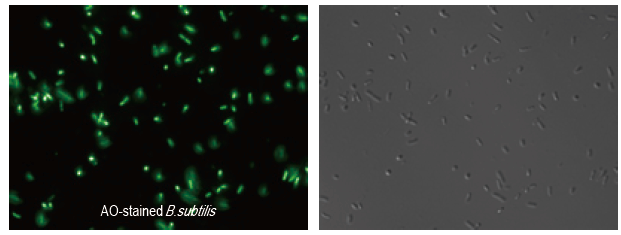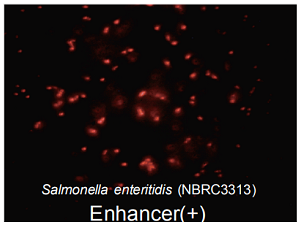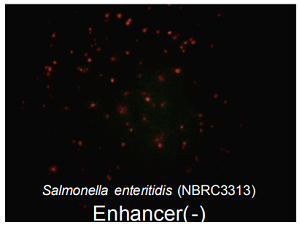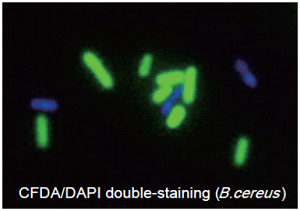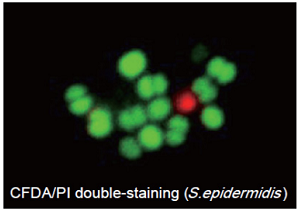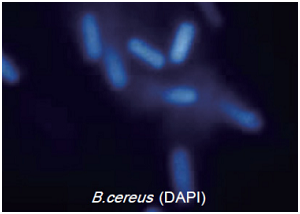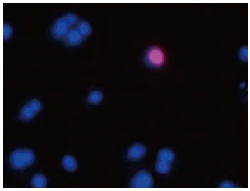Introduction
-Bacstain- series offer several kinds of bacterial fluorescence staining dye and can be applied for microbial cell viability assay in different principles.
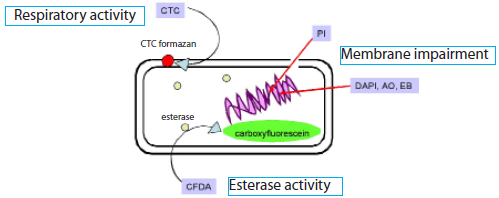
Acridine orange (AO) has been used as total direct counting dye in the environmental bacterial research and forms a complex with double-stranded DNA to emit green fluorescence. AO also forms a complex with single-stranded DNA or RNA to emit red fluorescence.
Mechanism of RNA and ssDNA Staining

Fig. 1 Mechanism of RNA and ssDNA Staining
Kit contents
| AO aqueous solution | 75 μl x 4, 1 mg/ml |
Storage
Store at -20°C.
Required Equipment
- Fluorescence microscope (blue excitation filter, green or red emission filter) or Flow cytometer (488 nm laser, green or red emission filter)
- Micropipette (20 μl, 1,000 μl)
Precaution
This includes microtubes containing solutions. Since there is a possibility that the droplets might attach to the inside walls or caps, please shake them down prior to open.
Staining Procedure
- Allow AO solution to stand at room temperature for 30 minutes for thawing. Solution should be protected from light a).
- Resuspend the organisms with PBS(-) or saline and adjust the number of cells to 106 cells/ml (flow cytometry) or 108-109 cells/ml (microscopy).
- Add 3 μl of AO solution into the 1 ml of microbial cell suspension and vortex gently to mix.
Formaldehyde-fixation (1–4% final concentration) can be recommended if necessary. - Incubate the microbial cells at room temperature for 5 minutes.
- Analyze the stained cells by flow cytometer or under a microscope.
a) Since AO may be carcinogenic, please be careful in its handling/disposing.
-
Left: Fluorescence image
Right: Bright field image
Number of Tests Possible
This kit can perform at least 100 tests for the flow cytometric assay and the microscopic assay by following the protocol described herein.
References
- J. E. Hobbie et al.,” Use of Nucleopore Filters for Counting Bacteria by Fluorescence Microscopy”, Appl. Environ. Microbiol., 1977, 1225.
- S. F. Nishino, “ Direct Acridine Orange Counting of Bacteria Preserved with Acidified Lugol Iodine”, Appl. Environ. Microbiol., 1986, 602.
Relevant Products
-Bacstain- CTC Rapid Staining Kit (for Flow cytometry)
-Bacstain- CTC Rapid Staining Kit (for Microscopy)
CTC has been used by many researchers to evaluate the microbial respiratory activity.
-Bacstain- CTC Rapid Staining Kit allows quick and high-sensitivity CTC-staining.
-
Right-image: without enhancing reagent
Left-image: with enhancing reagent
Ex filter: Blue
Em filter: Red
CTC staining efficiencies were compared in with or without enhancing reagent condition.
-Bacstain- CFDA solution
CFDA is widely used as an indicator for the measurement of esterase activity.
-Bacstain- CFDA solution is provided as Ready-to-Use DMSO solution.
Fluorescent carboxyfluorescein is produced from non fluorescent CFDA by the esterase in the microbial cell.
-Bacstain- DAPI solution
DAPI and EB are nucleic acid staining dyes and can be applied for bacteria either with membrane impairment or with intact membrane.
-Bacstain- PI solution
PI is a nucleic acid staining dye. Membrane-injured cells are stained with red emission by PI.
-
Double-stainig of S.epidermidis (DAPI/PI)
Red fluorescence represents membrane-injured cells
| Products | Code | Maximum Ex/Em (nm) | Number of assays |
| CTC Rapid Staining Kit (for Flow cytometry) | BS01 | 430, 480/630 | 100 |
| CTC Rapid Staining Kit (for Microscopy) | BS02 | 430, 480/630 | 100 |
| CFDA solution | BS03 | 493/515 | 100 |
| DAPI solution | BS04 | 360/460 | 100 |
| AO solution | BS05 | 420-460/630-650 (ssDNA) 500/520 (dsDNA) |
100 |
| EB solution | BD06 | 520-525/615 | 100 |
| PI solution | BD07 | 530/620 | 100 |
These products were developed by joint-research with Fukuoka Industrial Technical Center in Japan.
Frequently Asked Questions / Reference
BS05: -Bacstain- AO solution
Revised Aug., 24, 2023


 Hidden sections will not be printed.
Hidden sections will not be printed.